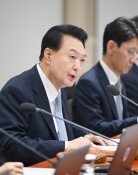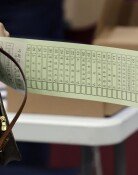Radiation levels around Fukushima reactor fall but fears remain
Radiation levels around Fukushima reactor fall but fears remain
Posted October. 15, 2012 03:08,
The village of Okumamachi in Japan`s Fukushima Prefecture is called a faceless village. Workers there cannot afford to remove their protective masks due to high levels of radiation, with areas around the village nearly empty and people hard to find.
Cows who lost their owners occasionally pose a major threat to the nighttime moving of workers at the plant. Korean media staff on Friday entered the nuclear reactor complex, which is off limits for ordinary people.
○ Village turns into ghost town
Reporters visited a village about 20 kilometers east of the plant at 8 a.m. Friday. Once a training facility for the Japanese national soccer team, the site is now a base camp for recovery work following the nuclear disaster in the area.
The volume of radiation at this site is 2μSv (micro sievert) per hour (hereafter all radiation levels are recorded on a per hour basis), fairly high compared with 0.11μSv in Seoul and 0.047μSv in Tokyo. But this is lower than the volume of radiation a person is exposed to from a one-time CAT scan (8,000μSv).
Forty-five journalists from Korea and foreign media including Reuters wore anti-radiation gear, three layers of gloves, two layers of shoe covers, hoods and masks. They departed for the plant at 9:50 a.m.
Laypeople are allowed to approach up to a radius of 10-20 kilometers from the plant. No sign of people was in sight there, however. Buildings remained unchanged after they collapsed from the massive earthquake last year.
Rice paddies and farm fields had not been cultivated for more than 19 months and showed a wave of yellowish weeds called solidago altissima, a name that sounds unfamiliar. The village has turned into a ghost town.
○ Horrible views within nuclear plant
As the bus loaded with reporters headed toward the sea, nuclear plant Nos. 1 to 4 appeared. Reactor 1, whose roof was covered with an ultra-large tent, looked intact on the surface but the fenced gate for entry and exit was twisted.
A vehicle remained upside down at a site right by Reactor 2. The radiation level surged to 100μSv at this site. An Off Limits sign stood between Reactors 1 and 2.
A source with Tokyo Electric Power said, At this site, the radiation level measured 10 Sv (or 10 million μSv) in August and September last year, adding, Since then, it has never been approached and thus the current radiation level is unknown. Death occurs if a person is exposed to 10 Sv of radiation for one hour.
When the reporters approached Reactor 4, the radiation level surged to 1,000μSv. The power company source said, This reading stems from radioactive materials that remain buried in the debris of contaminated buildings, adding, Readings of radiation levels soar at certain sites according to wind direction.
Reporters got off the bus at a site where the radiation level measured 95∼200μSv per hour. They were allowed to gather information there for 10 minutes.
The exterior walls of Reactor 4, whose roof was blown away due to a hydrogen explosion, had holes here and there and showed steel skeletons. From late next year, authorities will remove nuclear fuel rods at the water tank storing waste nuclear fuel in the upper part of the building.
Overall work has progressed at a snails pace. Nineteen months has passed since the disaster, but the plant site remains chaotic due to building debris. Takashi Takahashi, 55, director of the Fukushima plant, said, The pace of work is slow because we are conducting the project very cautiously to ensure worker safety. We are considering deploying robots.
○ Overall risk level declines
The radiation level around the Fukushima reactor reached 400,000 μSv at one point last year, but was just 1,000μSv even right by the plant Friday. This is the same permissible level that ordinary people can be artificially exposed to for one year. If a person is exposed to a radiation level permissible for one year for an hour, his or her health will take a hit but this will not prove fatal.
Jang Sun-heung, a nuclear and quantum engineering professor at the Korea Advanced Institute of Science and Technology and former chairman of the Korea Nuclear Society, said, Radiation levels have fallen to a level that has no effect on the human body except areas around the Fukushima nuclear plant, adding, Tokyo, which is about 200 kilometers from the power plant, can be considered safe. Radiation fears have subsided across Japan overall."
Experts, however, stressed the need to remain vigilant over food safety of food. Kim Moo-hwan, a professor of cutting-edge nuclear engineering at Pohang University of Science and Technology, said, Certain radioactive materials have a long half life, including cesium, and people should remain on alert for food safety for decades, adding, The fear is that a problem could arise when government screening loosens in three to four years.
Headline News
- Israel prepares for retaliation against Iran
- Samsung reclaims top spot, surpassing Apple in smartphone market
- 77% of Koreans in 20s and 30s are 'Kangaroo Tribe' due to job crisis
- KBO referees embroiled in controversy over ABS decision concealment
- Inflation, oil price surge put double shock on global economy







